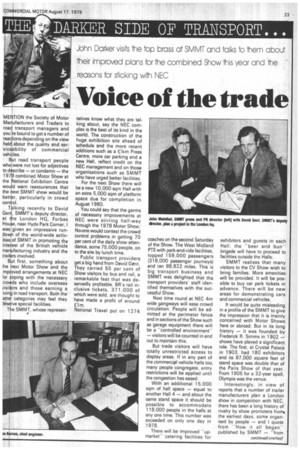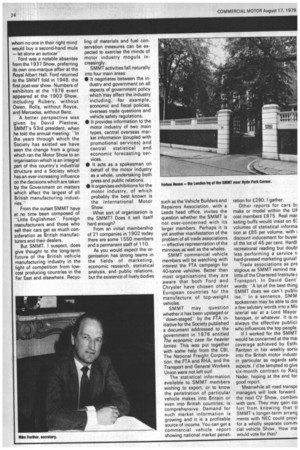Voice of the trade
Page 25

Page 26

If you've noticed an error in this article please click here to report it so we can fix it.
John Darker visits e top brass at SVIN/T and talks to them about eir improved plans for -ne combined Show is year anc e reasons for sticking with NEC
"ME TION the Society of Motor Ma ufacturers and Traders to roas transport managers and you e bound to get a number of reac ions depending on the view held about the quality and servic ability of commercial vehi les.
B t road transport people who were not lost for adjectives to d scribe — or condemn — the 197 combined Motor Show at the ational Exhibition Centre wou d want reassurances that the ext SMMT show would be bett r, particularly in crowd cont ol.
T lking recently to David Gen , SMMT's deputy director, at t e London HQ, Forbes Hou e, near Hyde Park Corner, I was given an impressive run
do of the world-wide activities of SMMT in promoting the Inte est of the British vehicle man facturing industry and the trad rs involved.
B t first, something about he ext Motor Show and the mp oved arrangements at NEC or oping with the necessary ro ds who include overseas iisi ors and those earning a ivin in road transport. Both the atte categories may feel they ies rve special facilities.
T e SMMT, whose represen tatives know what they are talking about, say the NEC complex is the best of its kind in the world. The construction of the huge exhibition site ahead of schedule and the more recent additions such as a £1/4m Press Centre, more car parking and a new Hall, reflect credit on the NEC management and on those organisations such as SMMT who have urged better facilities.
For the next Show there will be a new 10,000 sqm Hall with an extra 5,000 sqm of platform space due for completion in August 1980.
You could say that the germs of necessary improvements at NEC were stirring half-way through the 1978 Motor Show. No-one would contest the crowd control problems in getting 70 per cent of the daily show attendance, some 75,000 people, on to the site by lunch time.
Public transport providers get a big hand from David Gent_ They carried 55 per cent of Show visitors by bus and rail, a remarkable feat that was deservedly profitable. BR's rail inclusive tickets, 371,000 of which were sold, are thought to have made a profit of around Lim.
National Travel put on 1274 coaches on the second Saturday of the Show. The West Midland PTE with park-and-ride facilities, topped 159,000 passengers (318,000 passenger journeys) and ran 88,822 miles. This is big transport business and SMMT was delighted that the transport providers' staff identified themselves with the successful Show.
Next time round at NEC 4m wide gangways will ease crowd circulation. People will be admitted at the perimeter fence and in sections of the Show such as garage equipment there will be a "controlled environmentvisitors will be counted in and out to maintain this.
But trade visitors will have totally unrestricted access to display areas. If in any part of the commercial vehicle halls too. many people congregate, entry restrictions will be applied until the congestion has eased.
With an additional 15,000 sqm of hall space — equal to another Hall 4 — and about the .same stand space it should be possible to accommodate 118,000 people in the halls at any one time. This number was exceeded on only one day in .1978.
There will be improved -upmarketcatering facilities for
exhibitors and guests in each Hall: the "beer and bun" brigade will have to proceed to facilities outside the Halls.
SMMT realises that many visitors to the CV Show wish to bring families. More amenities will be provided. It will be possible to buy car park tickets in advance. There will be new areas for demonstrating cars and commercial vehicles.
It would be quite misleading in a profile of the SMMT to give the impression that it is mainly concerned with Motor Shows here or abroad. But in its long history — it was founded by Frederick R. Simms in 1 902 — shows have played a significant role. The first, at Crystal Palace in 1903, had 180 exhibitors and its 87,000 square feet of stand space was double that of the Paris Show of that year. From 1905 for a 32-year spell, Olympia was the venue.
Interestingly, in view of reports that a number of trailer manufacturers plan a London show in competition with NEC, there has been a long history of rivalry by show promoters from the earliest days, some organised by people — and I quote from "How it all began" published by SMMT — "from whom no one in their right mind would buy a second-hand mule — let alone an autocar".
Ford was a notable absentee from the 1937 Show, preferring its own one-marque affair at the Royal Albert Hall. Ford returned to the SMMT fold in 1948, the first post-war show. Numbers of exhibitors at the 1978 event appeared at the 1903 Show, including Rubery, without Owen, Rolls, without Royce, and Mercedes, without Benz.
A better perspective was given by David Plastow, SMMT's 53rd president, when he told the annual meeting: -In the years through which the Society has existed we have seen the change from a group which ran the Motor Show to an organisation which is an integral part of this country's industrial structure and a Society which has an ever-increasing influence on the decisions which are taken by the Government on matters which affect the largest of all British manufacturing industries.'"
From the outset SMMT have at no time been composed of "Little Englishmen". Foreign manufacturers and those who sell their cars get as much consideration as British manufacturers and their dealers.
But SMMT, I suspect, does give thought to the long-term future of the British vehicle manufacturing industry in the light of competition from lowcost producing countries in the Far East and elsewhere. Recyc ling of materials and fuel conservation measures can be expected to exercise the minds of motor industry moguls increasingly.
SMMT activities fall naturally into four main areas: • It negotiates between the industry and government on all aspects of government policy which may affect the industry including, for example, economic and fiscal policies, overseas trade questions and vehicle safety regulations.
• It provides information to the motor industry of two main types, central overseas market information (coupled with promotional services) and central statistical and economic forecasting services.
• It acts as a spokesman on behalf of the motor industry as a whole, undertaking both press and public relations.
• It organises exhibitions for the motor industry, of which probably the best known is the International Motor Show.
What sort of organisation is the SMMT? Does it sell itself hard enough?
From an initial membership of 21 companies in 1902 today there are some 1550 members and a permanent staff of 110.
As you would expect the organisation has strong teams in the fields of marketing, economic research, statistical analysis, and public relations, but the existence of lively bodies such as the Vehicle Builders and Repairers Association, with a Leeds head office, invites the question whether the SMMT is not over-concerned with its larger members. Perhaps it is yet another manifestation of the problem of all trade associations — effective representation of the minnows as well as the whales.
SMMT commercial vehicle members will be watching with interest the FTA campaign for 40-tonne vehicles. Better than most organisations they are aware that both Ford and Chrysler have chosen other European countries for the manufacture of top-weight vehicles.
SMMT may question whether it has been upstaged or "down-staged" by the FTA initiative for the Society published a document addressed to the government in 1976 entitled The economic case for heavier lorries. This was put together with some help from the CBI, The National Freight Corporation, the FTA and RHA, and the Transport and General Workers Union were not left out!
The statistical information available to SMMT members wishing to export, or to know the penetration of particular vehicle makes into Britain or even into British countries, is comprehensive. Demand for such market information is growing and it is a profitable source of income. You can get a commercial vehicle report showing national market penet
ration for £290. I gather.
Other reports for cars ID) make or model within the Ult cost members £975. Real mar keting buffs would insist on 6: volumes of statistical informa tion at £85 per volume, with discount inducement for buyer of the lot of 45 per cent. Hardl: recreational reading but doubt less performing a service tl hard-pressed marketing gurus!
Trade associations as pre stigious as SMMT remind me little of the Chartered Institute c Transport. In David Gent' words: "A lot of the best thing SMMT does we can't public ise." In a sentence, SMIV1 spokesmen may be able to dro a few salutary words into a Mir isterial ear at a Lord Mayor' banquet, or whatever. It is m always the effective publici: who influences the top people.
If I worked for the SMMT would be concerned at the mw coverage achieved by Esthi Rantzen in her weekly sortic into the British motor industr in particular as regards safe aspects. I'd be tempted to give six-month contract to Ralr Nader, hoping at the end for good report.
Meanwhile all road transpr managers will look forward the next CV Show, combino with cars. They may gain col fort from knowing that tl SMMT's longer-term arrang ments with NEC could provi for a wholly separate comm■ cial vehicle Show. How ma would vote for that?








































































































